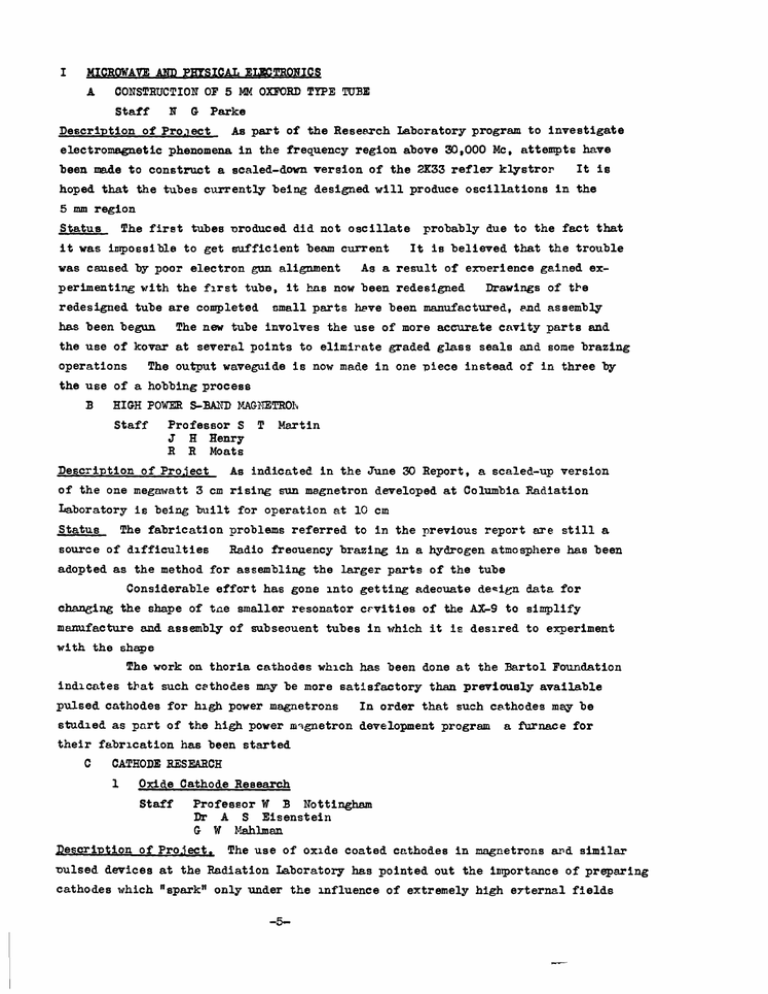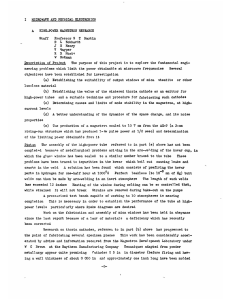I AND PHYSICAL EIZCTRONICS OF 5 A
advertisement

I MICROWAVE AND PHYSICAL EIZCTRONICS A CONSTRUCTION OF 5 MM OXFORD TYPE TUBE Staff N G Parke Description of Pro.ect As part of the Research Laboratory program to investigate electromagnetic phenomena in the frequency region above 30,000 Mc, attempts have been made to construct a scaled-down version of the 2K33 reflex klystror It is hoped that the tubes currently being designed will produce oscillations in the 5 mm region The first tubes nroduced did not oscillate Status it was impossible to get sufficient beam current was caused by poor electron gun alignment probably due to the fact that It is believed that the trouble As a result of exoerience gained ex- perimenting with the first tube, it has now been redesigned redesigned tube are completed has been begun Drawings of the small parts hove been manufactured, and assembly The new tube involves the use of more accurate cavity parts and the use of kovar at several points to elimirate graded glass seals and some brazing operations The output waveguide is now made in one piece instead of in three by the use of a hobbing process B HIGH POWER S-BAND MAGNETRO Staff Professor S T Martin J H Henry R R Moats Description of Project As indicated in the June 30 Report, a scaled-up version of the one megawatt 3 cm rising sun magnetron developed at Columbia Radiation Laboratory is being built for operation at 10 cm Status The fabrication problems referred to in the previous report are still a source of difficulties Radio freouency brazing in a hydrogen atmosphere has been adopted as the method for assembling the larger parts of the tube Considerable effort has gone into getting adeouate design data for changing the shape of tne smaller resonator crvities of the AX-9 to simplify manufacture and assembly of subseouent tubes in which it is desired to experiment with the shape The work on thoria cathodes which has been done at the Bartol Foundation indicates that such cathodes may be more satisfactory than previously available pulsed cathodes for high power magnetrons In order that such cathodes may be studied as part of the high power mqgnetron development program their fabrication has been started C a furnace for CATHODE RESEARCH 1 Oxide Cathode Research Staff Professor W B Nottingham Dr A S Eisenstein G W Mahlman Description of ProJect. The use of oxide coated cathodes in magnetrons and similar sulsed devices at the Radiation Laboratory has pointed out the importance of preparing cathodes which "spark" only under the influence of extremely high external fields -5- (0 9' WAVEGUIDE r rUTI AII 41NI FORMER. HK-7 OUT- TDsAlC~_ IN WINDOWIN WINDOW CONNECTOR Since the choice of cathode base metal and coating are known to influence the "sparking" properties, studies were undertaken to determine the fundamental manner in which each of these affects the "sparking" and emission properties of cathodes Status (a) Interface It is suspected that the influence of tne base metal is that of controlling chemic 1 reactions which occur at the interface between the base metal and coiting X-ray diffraction natterns show that cathodes prepared of a (BaSr)O coating on a 551Si-"i base metal always contain a BaSi03 interface layer betueen the oxide and the base metal -3 great as 10 cm This layer may have a thickness as Exoeriments are underway to measure the relttive electrical conductivities of (BaSr)O and BaSi03 in bulk so that the role of the interface in limiting the thermionic emission can be better understood (b) Coating Previous work in the Radiation laboratory indicated that the sparking properties of Ba0 were considerably better than those of SrO or mixtures of the two This investigation is intended to either verify or disprove this contention, and further, to observe how the sparking potential varies with temperature and work function (as measured over the range 900-1300eK) as the tube is "aged" by drawing direct current from it An investigation is being made of the sparking properties of oxidecoated cathodes as a function of (1) type of coating, (2) operating temperature, (3) work function, and (4) operating life Four were coated with pure Sixteen tubes have been processed BaC03 (before orocessing), four with pure SrCO3, four with a coating of nure BaC003 on top of a coating of pure SrC03, and four with a coating of pure SrCO03 on top of a coating of pure BaCO 3 The sixteen tubes were processed by the methods found to be successful during tne war This consists of binder removal, conversion of the carbonate to the oxide, and activation by drawing d-c current up to about 1/2 amp/cm 2 and pulse current up to about 2 20 amp/cma The tubes are then sealed off, and tested by applying a 1 micro-second pulse of known peak voltage and measuring the peak current from the oxide cathode pulse voltage is raised until "sparking" occurs 0 different temperatures in the range 900-1300 K The This is done for about four At this date, insufficient progress has been made to draw any definite conclusions 2 Emissivity of Tungsten Staff Professor' 7 W E Mutter Description of Project Nottingham Although tungsten is Drobably the most important emitter of light for illumination purposes, the spectral emissivity has not been determined as a function of the temperature in a manner that is satisfactory for the computetion of data applicable to tungsten fillaments Status An erperiment has been started to measure the emissivity of tungsten as a function of wavelength and temperature -7- Existing literature data at two wavelengths are in disagreement and it is expected that the present measurements will throw some light on this as well as extend the range studied to cover the entire visible and near ultra-violet The method to be used offers some marked advantages over the normal pyrometric technique in that the wavelength is accurately known and the measurement has no subjective aspects The image of a tubular tungsten source containing a small radial hole is focused on the entrance slit exit end, a horizontal slit of a monochromator At the of width smaller than the diameter of the hole in the source travels up and down along the regultr vertical slit of the instrument detected with a photocell and electrometer for various Dositions The emergent flux is of the traveling slit The ratio of the energy (current) from the surface of the source to the energy from the hole (block-body) gives the emissivity directly at a given wavelength The source for this work has been completed, but measurements have been delayed pending the installation of a high current d-c generator required for its operation 3 Electron Emission Studies Staff Professor W B A Fineman Nottingham C Tung This research has been in anticipation of studies of oxide-cathode material to determine the energy distribution of the emitted electron at various temoeratures of operation and to determine the emission as a function of the applied voltage Most previous studies on the question of enission as a function of applied voltage have yielded curious results because of the deactivation often encountered in such experiments It is not certain that we shall be able to avoid this deactivation but a design in which it will be minimized has been used D IONIZATION GAUGE RESEARCH Staff Professor N B Nottingham As a result of an investigation carried on early in 1946 it seemed desirable to make studies of the ionization gauge as a device for determining the presence of residual atoms in a vacuum system The conventional ionization gauges are likely to give faulty results because of the emission of electrons from the ion collector due to the absorption of soft x-rays generated at the surface of the electron collector is that it A second difficulty with the conventional ionization gauge is prone to oscillate if the vacuum becomes narticularly good the studies of a new gauge have been under way daring the past few weeks, are not of sufficient importance to report in detail at present -8- Although results I E HIGH VOLTAGE SPARK GAP TUBES Staff J Zuckerbraun The development of higher voltage spark gap tubes was initiated because of the possibility of their use in providing up to 100 kv pulses for Synchrotron injection Several of the experimental tubes were built in the Electronics Laboratory tube shop They differed essentially from previous available tubes in that the distance between the cathode pool and the anode could be varied Two types of tests were performed with these tubes (1) Tests under static conditions of voltage and current& (2) Tests under pulse conditions where the applied voltage was either of rectangular wave form or where the current was allowed to decay exponentially with time The results of the tests indicated the following (1) Tubes having a breakdown strength of 25 kr or higher can be built& (2) A current of 1 ampere through these tubes forms a high voltage glow discharge rather than a low voltage arcs (3) The time in which the glow is established depends largely on the rise time and magnitude of the trigger voltage and can be made to be less than 1 microsecond, (4) The time-jitter of breakdown also is largely influenced by the trigger pulse and can be made less than 0 3 microseconds for trigger voltages of about 35 kv with rise times of about 60 kv per microseconde (5) The amplitude-jitter of the tube drop is small and depends on the gap spacing, At the electrode separation needed for 25 kv tubes this jitter is about 200 volts per gap It appears feasible to use perhaps four of these tubes in series for 100 kv pulse Pulse width and amplitude can be controlled satisfactorily -9-





